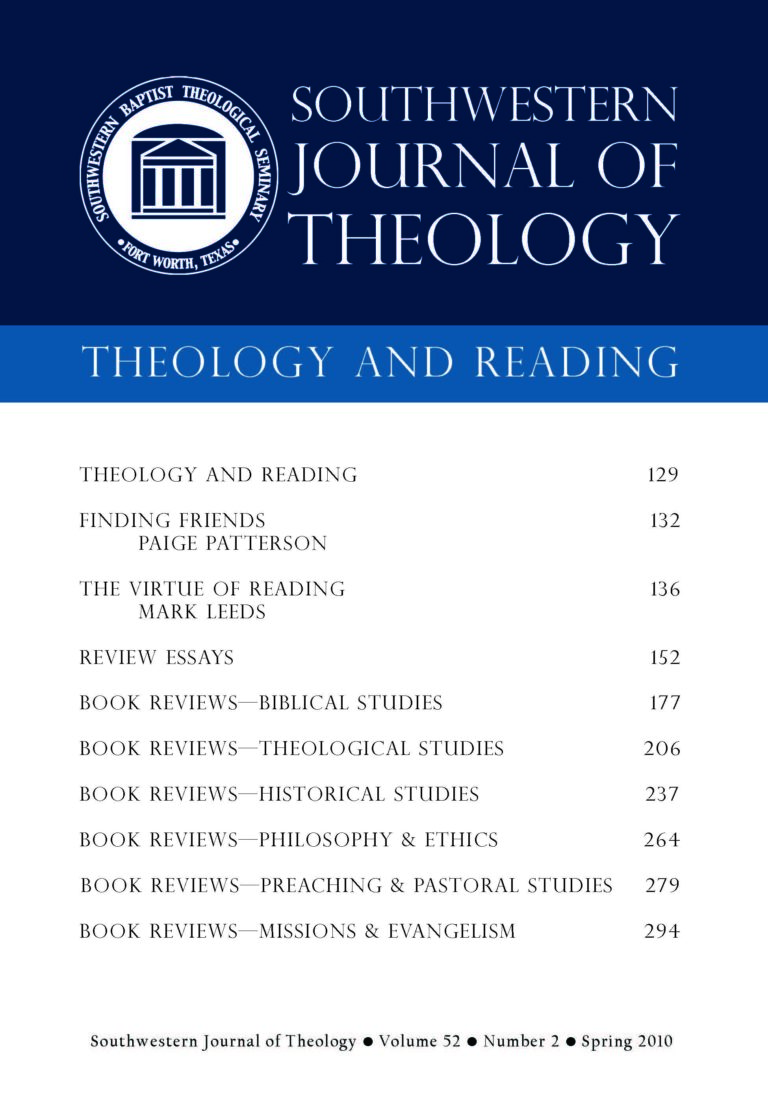
Theology and Reading
Southwestern Journal of Theology
Volume 52, No. 2 – Spring 2010
Managing Editor: Malcolm B. Yarnell III
By Scot McKnight. Grand Rapids: Zondervan, 2008. 236 pages. Hardcover. $19.99.
Scot McKnight’s The Blue Parakeet engages several interconnected discussions among contemporary Christians. McKnight addresses issues related to biblical interpretation (hermeneutics) as well as contemporary ethics. The pressing topic of the book is that today’s Christians need to have clear means of applying the Bible to contemporary life. McKnight deserves praise for his identification of several of the more difficult issues (“blue parakeets”) facing Christians who are trying to apply the Bible to everyday life.
McKnight indicates that there are cultural and historical gaps between biblical times and today. Therefore, those who are attempting to live according to the Bible must “adopt and adapt” (or “pick and choose”). McKnight attempts to present a means of adopting and adapting that is biblically warranted and timely. In order to engage the Bible and the contemporary context, McKnight argues that one must catch three essentials: story, listening and discerning.
In describing the story of the Bible, McKnight points to the over-arching story presented in five plot developments, each with their own theme. The themes of oneness (communion or mutuality—good) or otherness (individualism or subordination—bad) are central to McKnight’s presentation. The individual parts of the Story (Bible) are to be read in light of this oneness-otherness-oneness scheme. This big picture will help with the discerning task to come later.
Listening involves what McKnight calls a “relational” approach to the Bible (as opposed to an “authoritative” approach where the reader is primarily to submit to the Bible). The Bible serves as a personal communication to “us” from God. Noting the distinction between the Bible and God leads McKnight not to “ask what the Bible says” but instead “what God says to us in that Bible. The difference is a difference between paper and person” (91).
Discerning allows the reader, or perhaps better the listener, to find the proper way to live out the Christian life. McKnight says that discernment should be communal rather individual, will reflect diversity, and should be applied to “issues that are obviously unclear in the Bible.” McKnight says that no discernment is needed (because the Bible is clear) on murder, spousal abuse, selling children, or premarital sexual intercourse. However, discernment is needed (because the Bible is not clear) on women preachers and how gays and lesbians “will participate” (in the church) (131). Later, McKnight provides an extended discernment or case study on women in church ministries today, which argues an egalitarian position of expanding opportunities of church leadership for women due to the cultural norms of contemporary Western society.
Overall, The Blue Parakeet is an engaging read. McKnight has an uncanny ability to write in a manner that is both accessible and challenging. Throughout the book, McKnight intends to be provocative in language and through the questions he raises. For example, he begins chapter ten by stating, “Our all-too-glib but rather frequently heard Christian claim to practice whatever the Bible says annoys me.” He later asks, “Why do I not do what this passage in the Bible teaches?” (129). Unfortunately, in attempt to engage a more popular (“blog-savvy”) audience, McKnight’s assertions can occasionally be overstated, perhaps for rhetorical effect. In chapter three, as he critiques other “types” of approaches to interpretation and appropriation, McKnight states that “Roman Catholics, Eastern Orthodox, Lutherans, Reformed, Congregationalists, Baptists, Episcopalians, Presbyterians, nondenominational, and so on” all put the pieces of the Bible together as a puzzle. McKnight then contends, “Each of these groups ignores parts of the puzzle that don’t quite fit their system” (51, emphasis mine). McKnight does not want to grant that the other “parts” might be subsumed in the overall presentation because of some biblical warrant noted by these groups. Also, it might be that a more informed or detailed presentation of these groups’ positions might note the exceptions as being problematic but not incorrigible (and therefore not ignored).
One final comment about biblical interpretation or hermeneutics is in order. If the reader is looking for a book on hermeneutics, then this book should not be the first choice. McKnight either dismisses or “ignores” the distinction between meaning and significance made by E.D. Hirsch’s classic work, Validity in Interpretation. Though not everyone accepts Hirsch’s distinction, in McKnight’s case, it might be helpful if he were to distinguish between the effort in discerning the meaning of the biblical text and discerning useful means of appropriation for the text’s meaning. If the appropriation of meaning (“How do we live this text?”) and the quest for meaning itself (“What does this text say/mean?”) are coalesced, then the contemporary context of the reader might be given an undue place in the establishment of meaning. A destabilized textual meaning can hinder the “discerning” process that McKnight so encourages.





